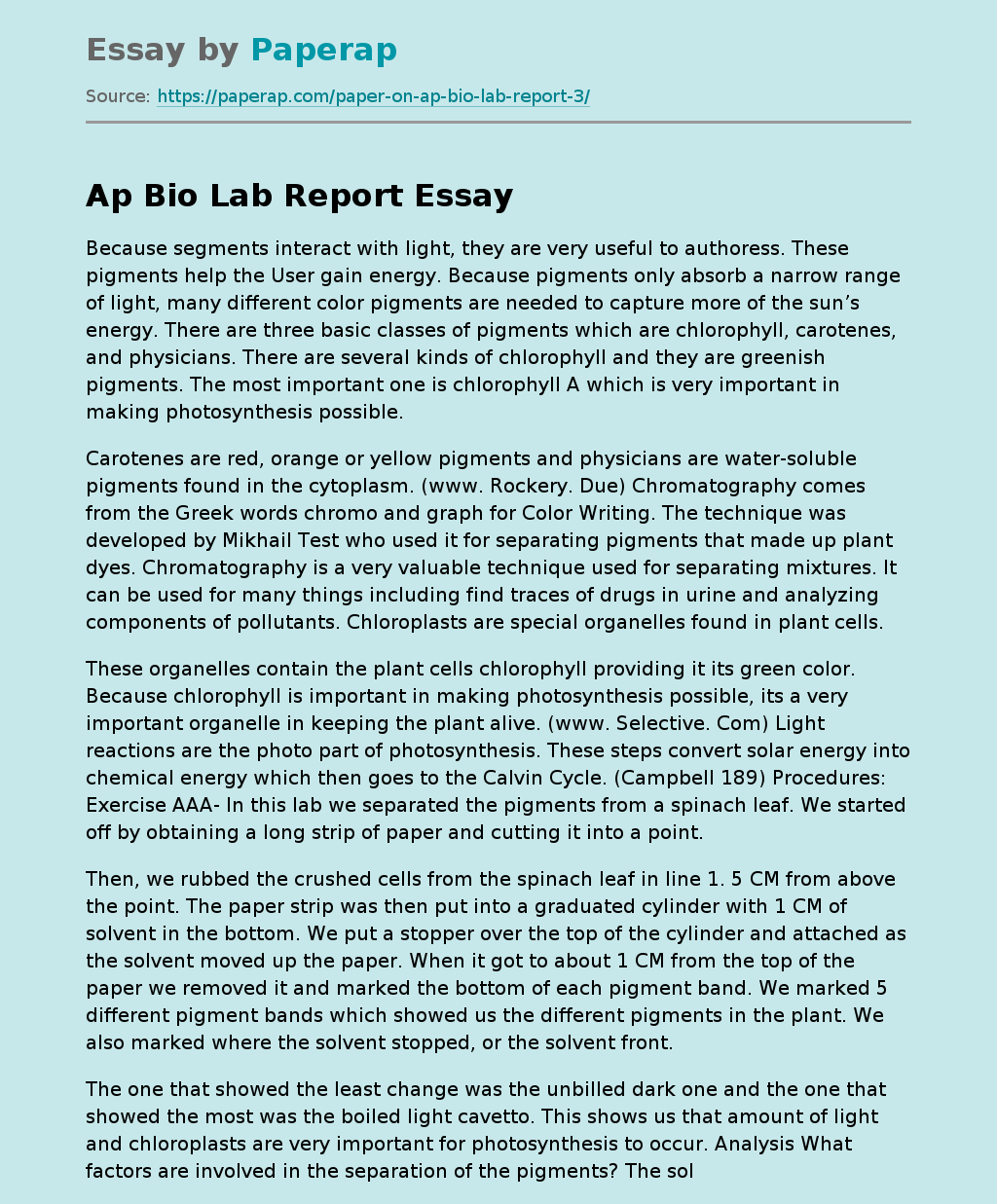Ap Bio Lab Report
Because segments interact with light, they are very useful to authoress. These pigments help the User gain energy. Because pigments only absorb a narrow range of light, many different color pigments are needed to capture more of the sun’s energy. There are three basic classes of pigments which are chlorophyll, carotenes, and physicians. There are several kinds of chlorophyll and they are greenish pigments. The most important one is chlorophyll A which is very important in making photosynthesis possible.
Carotenes are red, orange or yellow pigments and physicians are water-soluble pigments found in the cytoplasm.
(www. Rockery. Due) Chromatography comes from the Greek words chromo and graph for Color Writing. The technique was developed by Mikhail Test who used it for separating pigments that made up plant dyes. Chromatography is a very valuable technique used for separating mixtures. It can be used for many things including find traces of drugs in urine and analyzing components of pollutants. Chloroplasts are special organelles found in plant cells.
These organelles contain the plant cells chlorophyll providing it its green color. Because chlorophyll is important in making photosynthesis possible, its a very important organelle in keeping the plant alive. (www. Selective. Com) Light reactions are the photo part of photosynthesis. These steps convert solar energy into chemical energy which then goes to the Calvin Cycle. (Campbell 189) Procedures: Exercise AAA- In this lab we separated the pigments from a spinach leaf. We started off by obtaining a long strip of paper and cutting it into a point.
Then, we rubbed the crushed cells from the spinach leaf in line 1. 5 CM from above the point. The paper strip was then put into a graduated cylinder with 1 CM of solvent in the bottom. We put a stopper over the top of the cylinder and attached as the solvent moved up the paper. When it got to about 1 CM from the top of the paper we removed it and marked the bottom of each pigment band. We marked 5 different pigment bands which showed us the different pigments in the plant. We also marked where the solvent stopped, or the solvent front.
The one that showed the least change was the unbilled dark one and the one that showed the most was the boiled light cavetto. This shows us that amount of light and chloroplasts are very important for photosynthesis to occur. Analysis What factors are involved in the separation of the pigments? The solubility, size of particles, and their attractiveness to the paper. Would you expect the RFC value of a pigment to be the same if a different solvent were used? No, the different solubility of the pigments would change the RFC value.
What type of chlorophyll does the reaction center contain? What are the roles of the other pigments? The reaction center contains chlorophyll a. The other pigments collect other light waves and transfer the energy to chlorophyll a. What is the function of DIP in this experiment? It serves as an electron carrier and changes colors when accepting electrons. What molecule found in chloroplasts does DIP replace in this experiment? NADIA What is the source of the electrons that will reduce DIP? The electrons come from the photolysis of water. . What was measured with the spectrophotometer in this experiment? The effect of photosynthesis and the light in increasing amounts of time. The amount of light that passes through spec 20 measures the percent of light that passes through the cavity due to DIP reduction. What is the effect of darkness on the reduction of DIP? No reaction will occur because no photosynthesis is happening. What is the effect of boiling the chloroplasts on the subsequent reduction of DIP? Boiling denatures the protein molecules and stops reduction.
What reasons can you give for the difference in the percentage of transmittance between the live chloroplasts that were incubated in the light and those that were kept in the dark? No light was available in the dark cavetti so no photosynthesis, which caused for the DIP to stay dark allowing little light through. In the light cavetto, photosynthesis occurred causing for the DIP to clear up allowing more light through. Calvetti l:blank used to recalibrate the instrument between readings Cavetti 2: to observe the rate of photosynthesis without the presence of light Cavetti 3: to observe the rate of photosynthesis tit light.
Ap Bio Lab Report. (2019, Dec 05). Retrieved from https://paperap.com/paper-on-ap-bio-lab-report-3/

